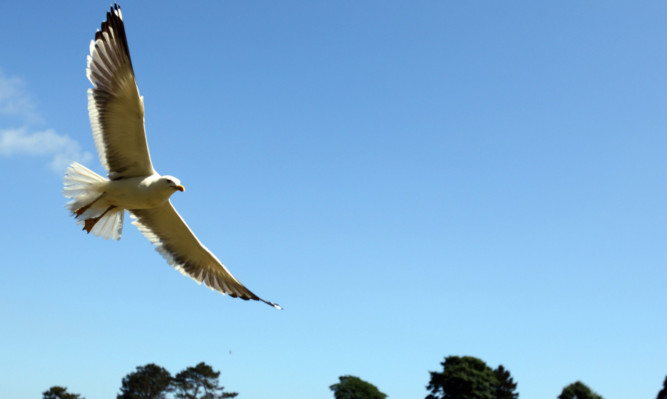With complaints about aggressive gulls soaring in recent years, Helen Brown looks at what can be done about this airborne pest.
On the wing, they are beautiful, soaring creatures, at home in their element, a joy to the eye. Closer to home, they can be predatory pests, scavenging for food, with no fear of humans or even animals while they are doing it. Complaints about seagull menace are on the rise. Across Courier Country, there have been reports of seagulls swooping to upset litter bins, grab food in the street or even attack domestic pets.
Some parents are reluctant to let their children go out because of the threat of dive-bombing.
It seems they are becoming more daring around people and become particularly aggressive in the April to July breeding season.
Seagulls are scavengers and it is reckoned by some authorities they now associate towns and cities (and their inhabitants) with food because the decline of the fishing industry has meant there are fewer scraps or discards from trawlers and increased recycling has reduced the amount of food waste on landfill sites.
The upsurge in fast food “on the go” and street litter in a throwaway society has also enticed them closer and closer to homes and town centres. The use of plastic sacks and fewer refuse collections is seen by some as an invitation to the birds to peck open rubbish bags in search of food. Better street lighting means they can feed at night.
So what can be done? Despite what beleaguered “townies” might think, the increase in urban gulls mainly herring and black-backed is not making up for overall decline. The seven breeding gull species in the UK are endangered. Councils and local authorities acknowledge the high nuisance factor but gulls, like all other birds, are protected by the Wildlife and Countryside Act of 1981. This prevents the reckless injury or killing of any bird or the damage or destruction of an active nest. In Scotland, it is also illegal to prevent birds from accessing their nest.
The act does allow the destruction of birds under certain circumstances but only when it can be shown that there is a risk to public safety or health and when all other non-lethal methods of control have tried and failed.
In such cases, the Scottish Government and Scottish National Heritage can issue licenses. Only the owner or occupier of an affected building can take action or they can give someone else permission to act on their behalf but any action taken must be humane the use of poison or drugs is prohibited except in exceptional circumstances and under special licence.
Elite Falconry, based in Fife, offers a pest control service involving raptors as well as a range of other methods. They are licensed by the Scottish Government and Roxanne Peggie of Elite explained: “Using falconry as a deterrent only works if it’s done full time, all day every day during nesting.
“A bird of prey will drive gulls crazy temporarily but once they’re gone, the gulls will come back unless they begin to associate the raptor with the place and move on. That takes time and regular exposure, sometimes combined with the destruction of eggs, nest and chicks.
“We work with many clients on a long-term programme of prevention a young gull can come back to its birth site up to five or seven years after it has fledged. I would hope to be called out in February/March to start preventative measures before breeding and nesting in April to July. We might make 10 12 visits over the summer, usually in the early morning between 3 and 4am to avoid public upset.”
Recently, Roxanne was called out by a group of householders in Rosyth. “The majority of our work involves warehouses or factories with large roofs to nest on but more individuals than ever before are contacting us. When we get a call we do a site survey and assessment. This kind of intervention is a one-off, late in the season when there is no other way to control the gull colony. If we need to, we use a non-firearms air rifle and to the onlooker it looks just like a sniper rifle so if anyone is liable to be concerned, we’ll alert the police or local council about our plans.
“Nobody actually wants to have to kill or dispose of the birds it’s very much a last resort and we would always encourage people to get in touch early so that we can prevent a colony settling and having something to defend and feed.
“Anyone who hasn’t seen them up close won’t know how big, powerful and loyal they are they don’t take their own safety into account when protecting their young. They are formidable.”
Roxanne added: “Two things are very important for the public. The first is, it is actually an offence to feed a seagull and the second is that if anyone knows where a nest is, they should never touch it. Seagulls build nests out of all kinds of unpleasant items and carry diseases like E.coli and salmonella.”
